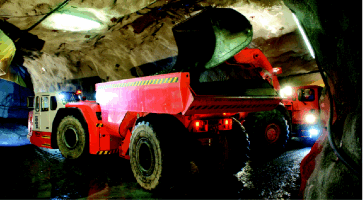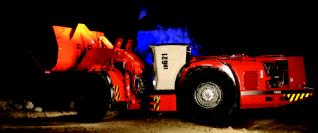By Howard James
Sandvik, one of the leading suppliers of heavy machinery to the mining industry, is teaming with its engine supplier, Volvo Penta, to achieve major reductions in NOx and DPM emissions from their loaders, haulers and other machines.
 |
| Ventilation can account for more than one-third of a typical mine’s electrical power cost. Reducing emissions from diesel engines has a direct, positive impact on lowering operating costs by reducing ventilation requirements to run the machines. Volvo Penta is using selective catalytic reduction systems on its engines to meet EPA Tier 4 standards for NOx and DPM emissions. |
“We share with Volvo Penta a strong corporate commitment to protecting the environment and worker health. Although the international clean-air regulations provide a certain level of flexibility in meeting the new EPA Tier 4 standards, we decided to be in the forefront of developing and implementing these new technologies,” said Dale Rakochy, product line support manager for Sandvik Mining, based in Ontario, Canada.
Reducing Emissions
Volvo Penta is using selective catalytic reduction (SCR) systems on its engines to meet the coming EPA Tier 4 standards for NOx and DPM emissions. The SCR system uses catalysts to convert dangerous NOx gas into harmless nitrogen and water molecules. Bob Apple, Volvo Penta vice president, industrial markets, North America, said, “We made a decision to focus on SCR technology as an optimal way to meet the clean-air requirements. We discovered that with our innovative SCR engineering we could also eliminate the need for a separate diesel particulate filter (DPF).”
A side benefit of the Volvo Penta solution is that—unlike cooled exhaust gas recirculation (EGR) systems—their SCR system produces less heat as a byproduct of the process, and radiator size can be greatly reduced. “Utilizing Volvo Penta SCR engines, we are able to use the same size radiator as a Tier 2 engine. The smaller radiator size improves visibility for the operator without raising the overall height of the vehicle,” said Rakochy.
Apple said Volvo Penta Tier 4 interim compliant 13L and 16L engines have received certifications from the U.S. Mine Safety and Health Administration and Canadian CANMET-MMSL. The company expects its full range of Tier 4 final engines to be available for delivery in 2014.
“We started installing Volvo Penta TAD1251VE Tier 3 engines in our TH430 underground trucks about three years ago,” said Rakochy. “Since then, our relationship with Volvo Penta has evolved, and all of our large loaders and trucks are now powered by their Tier 4i/Stage IIIB engines.
“Our research revealed that Volvo Penta Tier 4 engines have a much cleaner profile than other engine manufacturers we tested. Their particulate and NOx output levels are among the best in the industry,” said Rakochy.
 |
| Sandvik says that, in some cases, it’s possible for a mine to run two machines with its low- emissions engines in an area where they could only operate a single machine before—with no increase in ventilation. |
Calculating the exact costs of ventilation can be tricky. There are many variables in delivering the right amount of fresh air to the right zone at the right time. But Rakochy said there seems to be general agreement on the following “rule of thumb.” It costs approximately $5 per year for every cubic foot per minute (CFM) of underground ventilation required, he said. For example, if the machine requires 25,000 CFM of ventilation air to operate underground, the ventilation cost for that machine will be $125,000 per year.
CANMET certification test data (http://www.nrcan-rncan.gc.ca/mms-smm/tect-tech/ade-mdh-eng.htm#c) shows that the Volvo Penta Tier 4i engines typically require about 50% of the CFM ventilation rates compared to Tier 3 engines used in other machines. For instance, the Sandvik LH514 with a 343-hp (255-kW) Volvo Penta D13 Tier 4 engine requires just 11,000 CFM, while a competitor’s machine with a similar size Tier 3 engine needs 21,300 CFM ventilation. Using Rakochy’s rule of thumb, that translates into $51,500 in annual savings per machine.
“In some cases, it’s possible for a mine to run two machines with our low-emission engines in an area that they could only operate a single machine before with no increase in ventilation,” Apple said.
With those sorts of figures, it’s easy to see why mine operators are eagerly embracing the new green engine technology. Emissions reductions are only part of the benefits the green diesel engines offer. Machines powered by the new-generation diesel engines also provide higher productivity, better torque, less downtime, lower fuel consumption, reduced heat signatures, and optimized payload per envelope size and empty vehicle weight ratios, according to Sandvik. These also have an impact on operating costs. For instance, a 10% reduction in fuel consumption rate not only saves money in fuel costs, but it also means less frequent stops to refuel. That means more uptime.
Minimizing Downtime
Rakochy noted that a key factor in Sandvik’s success in implementing these new-technology engines has been the engineering, technical support and onsite service from the Volvo Penta team and their worldwide dealer network. “With the nature of mining, time is critical. Depending on the customer needs, service support needs to be dispatched to match their needs as quickly as possible,” Rakcohy said. “While Volvo is new in Sandvik underground mining equipment, they have a robust support network in place for the healthy business they enjoy in their other market segments—on-road, off-road, marine and power generation. We can leverage this expertise and their support network. We can often establish a working relationship, for instance, with a nearby Volvo Construction Equipment dealer to be the front-line service provider at a given mine site.
“When the need arises to dispatch service people to the mine site, usually they will be on site within 24 hours,” he said, noting that in a majority of cases, repairs will need to be made to the machines underground, rather than bringing them to the surface.
“As we populate new sales areas with Volvo Penta powered equipment, we organize training events involving the Sandvik service organization, the customer’s service team and usually the appropriate Volvo dealer. Training is provided by the Volvo Penta technical training team. When field problems occur, the customer can call upon either Sandvik or the Volvo dealer for assistance. Should the problem require higher skill levels, the extended Volvo support network will provide assistance, coming to the customer site if necessary,” Rakochy said.
“It’s natural to have a learning curve with any new technology, and the new Volvo Penta engines are no exception. But there is tremendous effort and cooperation between all parties at the outset to educate, train and raise the level of competence and familiarity with the product,” he said.
“When introducing a new engine underground there is some trepidation, but we have yet to receive any negative feedback where the customer has suggested he has made a mistake in purchasing the equipment,” Rakochy said. “On the contrary, we have customers come back and ask about retrofitting older machines with the Volvo Tier 4i engines.”
James is a freelance writer who covers construction and mining equipment.









